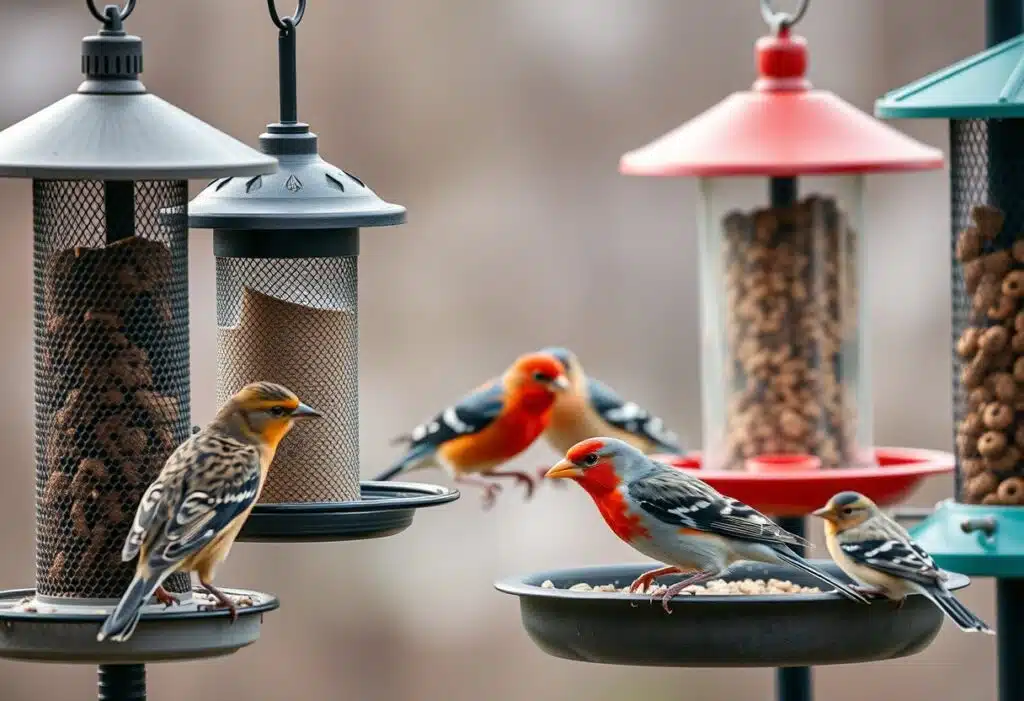What is The Best Bird Feeder to Prevent Disease?
As you sit back and enjoy the delightful company of wild birds visiting your backyard feeder, have you ever stopped to think about the importance of keeping those feeders clean and free from disease? Bird diseases can spread quickly, and it’s crucial to choose a feeder that not only attracts a variety of birds but also prioritizes their health and safety. In this article, we’ll explore the best bird feeders that will help you create a healthy and enjoyable bird-watching experience.
Key Takeaways:
- Easy to clean feeders are imperative to prevent the spread of bird diseases. Look for feeders with easy-to-remove parts and smooth surfaces that can be quickly cleaned and disinfected to prevent the spread of avian flu.
- Tube feeders attract a variety of birds and are especially effective for keeping birds like finches and sparrows fed., including finches, chickadees, cardinals, and other avian species. They are a great option for those who want to attract a range of bird species to their yard.
- Hopper feeders are ideal for larger birds, such as bluebirds and woodpeckers. They have larger perches and can hold more seed, making them a great option for those who want to attract bigger birds to their yard.

Best Bird Feeders
Your search for the perfect bird feeder ends here! After testing 10 popular models, we’ve narrowed down the best bird feeders that are both effective and easy to use.
Best Bird Feeder: Brome Squirrel Solution 200
Feeder enthusiasts, rejoice! The Brome Squirrel Solution 200 is a top choice for attracting a wide range of birds while keeping away unwanted pests. Its thoughtful design makes it easy to use, and its sturdy metal construction can hold up to 3.4 pounds of bird food. With six feeding ports and spacious perches, this feeder is a hot spot for goldfinches, chickadees, titmice, and even larger songbirds like bluebirds and cardinals. [It’s imperative to choose a feeder that’s easy to clean to prevent the spread of disease.]
Best Hopper Bird Feeder: Wild Birds Unlimited EcoTough Classic Feeder
Bird lovers, meet your new favorite feeder! The Wild Birds Unlimited EcoTough Classic Feeder is a durable and easy-to-fill hopper feeder that can accommodate larger birds. Its spacious perches and seed trays provide enough room for multiple birds to eat at the same time, and its unique “perch drains” feature allows seeds and empty shells to fall out of the trays more easily. [When choosing a feeder, consider the type of birds you want to attract and the ease of cleaning to prevent disease transmission.]
Indeed, the EcoTough Classic Feeder is a welcome addition to any backyard, helping to keep bird populations thriving. Its large seed trays and easy-to-fill design make it a hit with birds, and its durability ensures it will withstand any weather. With its ability to attract a wide range of avian species, including larger birds like jays and doves, this feeder is a must-have for any bird enthusiast.

Types of Bird Feeders
Even if you’re new to bird feeding, you’ve likely noticed that there are many types of bird feeders available. To choose the best one for your yard, it’s imperative to understand the differences between them. Assume that each type of feeder, including seed feeders and hummingbird feeders, attracts specific bird species and offers unique benefits.
| Type of Feeder | Description |
|---|---|
| Tube Feeder | Narrow, tall feeder with multiple ports and perches, suitable for smaller bird species |
| Hopper Feeder | Larger feeder with a roof, accommodating bigger bird species and offering a higher seed capacity |
| Platform Feeder | Open tray feeder, attracting a wide range of bird species, including ground-feeding birds |
| Suet Feeder | Square-shaped cage feeder, specifically designed for suet, appealing to woodpeckers and other bird species |
Tube Feeders
After considering the types of bird feeders, tube feeders are a great option for beginners. They’re easy to use, clean, and maintain, making them a popular choice among bird enthusiasts. Tube feeders are ideal for attracting smaller bird species, such as finches, chickadees, and titmice.
Hopper Feeders
Against the backdrop of tube feeders, hopper feeders offer a more spacious design, accommodating larger bird species like cardinals, bluebirds, and woodpeckers. Their roofs help keep the seed dry, and they often have a higher seed capacity than tube feeders.
Even more, hopper feeders are known for their ease of use and cleaning. They’re a great option for those who want to attract a wider range of bird species, including both common and rare avian visitors, to their yard.
Platform Feeders
Before selecting a bird feeder, consider platform feeders, which are open trays that allow birds to feed freely. They’re perfect for attracting bird species like jays, doves, grosbeaks, and sparrows, ensuring a diverse bird population in your garden.
Feeders like platform feeders are also great for attracting ground-feeding birds, such as quail or other species, depending on your location. [Keep in mind that platform feeders can be messy and require more frequent cleaning.]
Suet Feeders
Below the surface of traditional bird feeders, suet feeders offer a unique way to attract woodpeckers, nuthatches, titmice, chickadees, and wrens, making them essential for feeding birds in winter. They’re designed to hold a block of suet, a mixture of fat and seeds.
Plus, suet feeders are a great option for those who want to attract a variety of bird species to their yard, especially during the winter months when natural food sources are scarce. [Remember to choose a suet feeder that’s easy to clean and maintain.]

Where to Place a Bird Feeder
To attract a variety of birds and prevent disease transmission, place your bird feeder in an open area, at least 3 feet off the ground, and 10-15 feet away from any structures or trees. This allows birds to fly in and out safely and easily, while also reducing the risk of predators and disease spread. Additionally, consider placing your feeder near a window or a bird bath to create a bird-friendly habitat and keep birds coming back. Avoid placing feeders near bushes or shrubs, as they can harbor predators and create hiding spots for sick birds. By strategically placing your bird feeder, you can create a safe and welcoming space for your feathered friends and help feed birds in your area.
How to Maintain a Bird Feeder
For cleanliness and disease prevention, it’s necessary to regularly maintain your bird feeder. Dirty feeders can spread disease, so make it a habit to clean your feeder every two weeks. Start by removing any debris, such as seed hulls and droppings, from the feeder. Then, mix a solution of one part bleach to nine parts water, and soak the feeder for about 10 minutes. Rinse thoroughly with clean water, and let the feeder dry completely before refilling it with fresh bird seed to ensure the health of your avian visitors. By following these simple steps, you’ll create a healthy environment for your feathered friends to enjoy.
How We Tested
Unlike other reviews that rely on speculation, we took a hands-on approach to find the best bird feeder. We tested 10 popular models, including tube, finch, and brome feeders, to see how they performed in real-world conditions. We evaluated each feeder on its ease of use, construction quality, and the variety of birds it attracted. We also considered factors like cleaning and maintenance, as well as the overall value for the price. By putting these feeders through their paces, we were able to identify the top performers that will help you attract a wide range of birds to your yard.

Other Bird Feeders We Tested
Now, let’s take a look at some other bird feeders we tested that didn’t quite make the cut as our top picks. While they may not have been the best, they still have some great features that might make them a good fit for your backyard. We tested 10 popular models, including tube, finch, and hopper feeders, evaluating each one on how easy it was to fill, set up, and clean, as well as the quality of its construction and what kinds of birds it attracted. Some of these feeders were close contenders, but ultimately, they didn’t offer the same level of performance and value as our top picks.
To wrap up
Following this comprehensive guide, you now have a better understanding of what makes the best bird feeder to prevent disease. By choosing a feeder that is easy to clean, such as the Brome Squirrel Solution 200 or the Wild Birds Unlimited EcoTough Classic Feeder, you can help keep your bird friends healthy and happy. Recall, keeping your bird feeder clean is crucial in preventing the spread of disease among wild birds. By doing so, you’ll be able to enjoy the beauty of bird watching while also contributing to the well-being of these amazing avian creatures.
FAQ
Q: What is the best bird feeder to prevent disease?
A: The best bird feeder to prevent disease is one that is easy to clean and maintain. Look for feeders with features like removable parts, smooth surfaces, and drainage holes to prevent moisture buildup, which is crucial for keeping bird seed fresh. The Brome Squirrel Solution 200 and Wild Birds Unlimited EcoTough Classic Feeder are great options that are easy to clean and can help prevent the spread of disease.
Q: How often should I clean my bird feeder?
A: It’s recommended to clean your bird feeder every two weeks to prevent the buildup of bacteria and mold. You can use a mild detergent and water to clean the feeder, and make sure to rinse it thoroughly before refilling it with seed.
Q: What type of bird feeder is best for attracting a variety of birds?
A: A tube feeder is a great option for attracting a variety of birds. They can be filled with different types of seed, and their design allows for multiple birds to feed at once. The Brome Squirrel Solution 200 is a great example of a tube feeder that can attract a wide range of bird species.
As a bird enthusiast with a passion for sharing the wonders of our feathered friends. As a writer and nature lover, I'm thrilled to connect with fellow bird buffs and inspire others to take flight into the fascinating world of birds. Let's wing it together!


